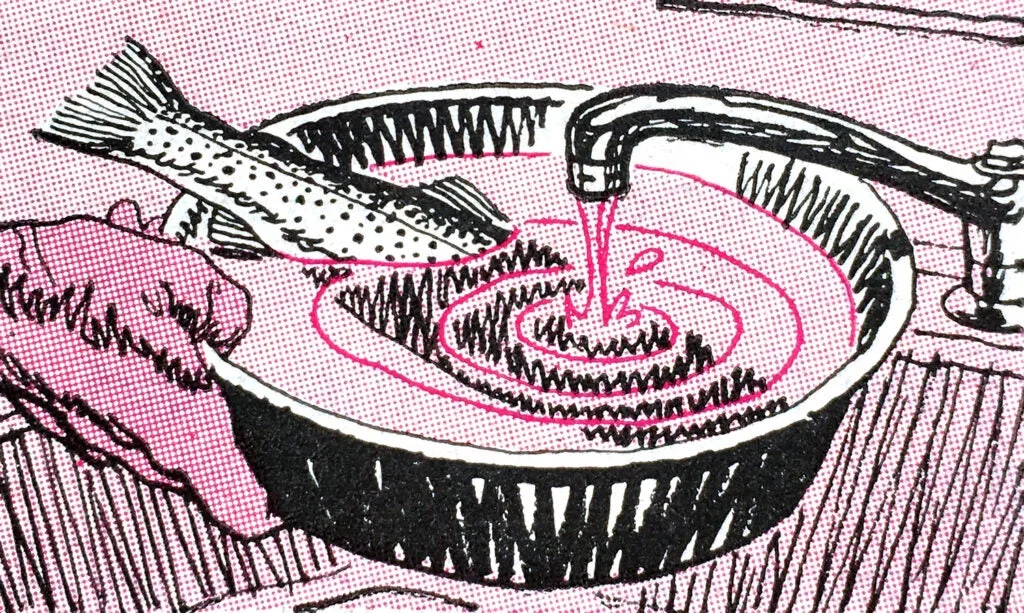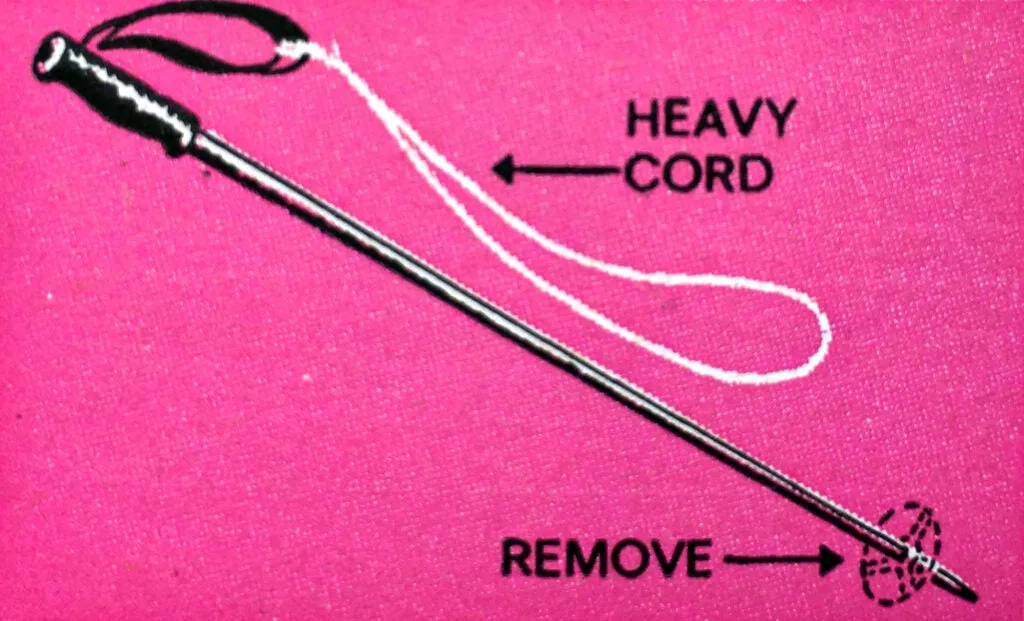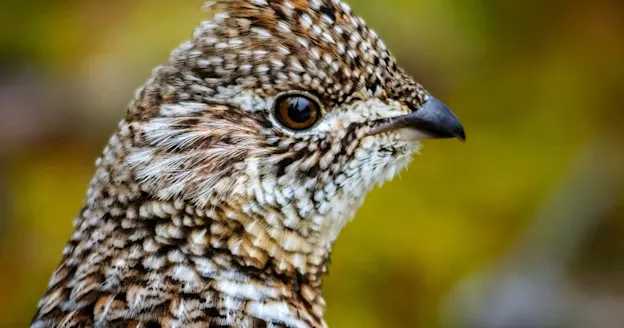For three and a half decades, H.G. “Tap” Tapply dolled out hard-earned wisdom on all things outdoors in his monthly column, Tap’s Tips. Here, we have compiled 40 of his best fishing tips from the ’60s and ’70s. Tapply specialized in quick, clever solutions to common problems—many of which are sure to solve your modern-day woes. —The Editors
1. Repair a Plastic Worm

A plastic worm that has been torn or cut in half can be stuck together very easily. Heat the two ends over a lighter till they melt, then hold them together while the plastic hardens. The “weld” will be as strong as the original worm.
2. Give Sparkle to a Lure

You can brighten tarnished spoon and spinner blades, or paint a glittery body on a streamer fly hook, with an “ultra-iridescent” sparkling fingernail polish. It can be found in copper and silver colors in a small bottle with a brush applicator, and costs only two bits.
3. Buff a Busted Guide

When you find line-grooves in a rod guide, usually at the tip top, you can buff them away with thin strips of emery cloth. But this leaves a rough surface, so always finish the job by polishing the inside of the guides with crocus cloth (jeweler’s rouge).
4. Dry Out a Tackle Box

When you return home after a day of fishing, make it a habit to leave your box of lures or book of flies open overnight so the contents can dry out. Moisture trapped in an airtight container will soon rust hooks and tarnish metal lures.
5. Motor TLC

When you run your boat ashore after a day’s fishing, stop the motor by disconnecting the fuel line and letting the motor idle till the carburetor runs dry. This will eliminate the chance that fuel may leak out when you put the kicker in the car trunk.
6. Thaw a Fish

A frozen fish should be thawed slowly. Either put it in the refrigerator 24 hours before cooking it or place it in cold water. If the fish is thawed too fast, the outside flesh may deteriorate while the inside is still frozen too hard to cook through.
7. Protect Your Eyes While Tying Flies

To provide a contrasty background for tying flies, paint the tying table soft white or another light shade, or use self-adhering, shelf-lining material in a solid color (light green is ideal). It’s easier on the eyes when tying very small flies.
8. Maximize the Flavor of Fish

As a rule of thumb, fish should not be kept in the refrigerator longer than two days before being cooked, for they lose their flavor rapidly. If it is necessary to keep the fish any longer than two days, it is better to quick-freeze them instead.
9. Keep Rod Ferrules from Sticking

Two tips for keeping rod ferrules from sticking: One, don’t lubricate them, because oil or nose grease collects dust and dirt. Keep both ferrules dry and clean. Two, take the rod apart as soon as you quit fishing so the metal can’t oxidize and lock.
10. Fix Wader Leaks with a Worm

Small leaks and briar-pricks in boots or waders can be plugged temporarily by melting the end of a plastic worm and smearing the hot goo over the hole. The plastic hardens in a few seconds and sticks well. (Suggested by Mark Knight, Kansas City, Mo.)
11. Keep Your Net from Snagging

Of the many ways to prevent the mesh of a landing net from becoming entangled in brush, twigs, and barbed wire fences, this is the simplest: Slip a heavy rubber band over the handle of the net and tuck the tip-end of the net bag under it.
12. Make a Makeshift Wading Staff

An old (but not broken) ski pole makes an excellent staff for wading heavy water. Remove the basket at the bottom of the pole and attach a cord to the thong at the top so you can let go of it when you have waded into position to fish.
13. Keep Trolling Lures from Twisting

Some trolling lures revolve one way, some the other. If you know the direction in which your favorite lures spin, you can change from a clockwise to a counterclockwise lure to prevent, or reduce, line-twist. Even so, it is wise to use a trolling keel.
14. Keep Bait in a Jar

L. F. Manning of Norwood, Pa., tells me he doesn’t use a bait bucket for carrying minnows. He puts them in a sealed, pint-sized Mason jar about two-thirds full of water; says a dozen minnows stay frisky all day if he changes the water every few hours.
15. Catch More Trout in High, Cold Water

When fishing high, cold water in the early spring with spinning gear, try casting diagonally upstream and retrieving just fast enough to keep the lure from hanging on bottom. This often takes sluggish trout that refuse to budge for anything else.
16. Don't Let the Fish "Hear" You

A noisy approach can spoil a good fishing spot, so kill the motor and drift in quietly, then ease the anchor down slowly. When you start fishing, talk all you want, but try to avoid banging or scraping against the boat, for those noises fish can “hear."
17. Secure Your Bait Bucket

Ever knocked over your minnow pail and spilled your day’s supply of ice-fishing bait? It’s less likely to happen if you put a good-sized rock in the bottom; then if you accidentally kick the bucket, the rock may prevent it from tipping over.
18. Make a Cooler Colder

You can keep a little cooler when fishing under a hot summer sun if you line the inside of your hat with aluminum foil, which acts as a heat reflector. It also helps if you wet your hair occasionally; it has a cooling effect as it evaporates.
19. Find Big Fall Bass

October is the time when bass start to move out into their winter quarters. The larger ones, especially, seek out the deeper holes. One way to locate them is to scratch bottom in from 10 to 20 feet of water with a plastic worm fished very slowly.
20. Use a Spiderweb to Match the Hatch

You can often tell what type of mayfly has been hatching recently on a trout stream by looking for spider webs in the bushes and especially under bridges. A few flies always get tangled in webs, and you can match them if they hatch again.
21. Quick-Freeze Your Catch

Game or fish from the home freezer often doesn’t taste as good as you expected. One reason, it may have been kept too long. Another, more common, reason: It wasn’t quick-frozen. Many home freezers don’t run cold enough to quick-freeze food.
22. Use the Right Kind of Moth Ball in a Fly Box

Recently I warned against putting mothballs in plastic fly boxes because they discolor and soften the plastic. But Col. J. R. Grey of Sacramento, Calif., tells me only those made with paradichlorobenzene do this; repellents with naphthalene do no damage.
23. Save Those Feathers

Fly tyers prize the barred and black-tipped side feathers from drake wood ducks, so if you shoot a male woodie this fall be sure to save these feathers and give them to someone who ties flies. He’ll be so grateful he’ll probably force some flies on you.
24. How to Loosen Ferrules

Rod ferrules that fit too tightly can be loosened a little by polishing them with petroleum jelly. Swab it on the ferrules and put them together and pull them apart several times, then wipe them clean. The two parts will slide together much easier.
25. Give Your Worm a Spiraling Action

The sketch shows how Douglas Heathcock of Wellington, Ala., hooks a plastic worm to make it twist when retrieved. He reports that the spiraling action brings bass up from deep water and out of the weed beds even when the worm is fished on the surface.
26. Assemble a Reel Repair Kit

You can usually keep your spinning and bait-casting reels in working order with a tiny screwdriver and a small crochet hook, one for making repairs, the other for picking out line tangles. Carry one of each in both boxes of lures and you’ll be ready for trouble.
27. Find Big Trout at Dusk

Look for trout at the tail end of big pools at dusk. They drop down into the apron of slick, shallow water as evening approaches to feed on nymphs and hatching flies and are quite easy to take if you can get a fly over them without drag.
28. Learn How to Use a Barometer

A barometer can really tell you if you can expect good fishing. Whether it is high (over 29.90 inches sea level pressure) or low isn’t nearly so important, however, as whether it is rising or falling. Fish bite best when the barometer is rising.
29. Cut Icefishing Holes Close Together

When ice-fishing for species that travel in schools, like perch and walleyes, cut your holes close together instead of scattering them. A light cluster of baits will hold the attention of a school of fish much longer than will a single bait.
30. Steam Fly-Tying Feathers

Fly-tying feathers that have become matted and misshapen in storage can be restored by steaming them, just as flies can. Put a handful in a flour sifter, hold it over the steaming spout of a tea kettle, and shake it as if you were popping corn.
31. Keep Your Boat More Stable

If your boat pounds when running into a chop, why put up with it? Bring the bow down by moving weight forward, or adjust the tilt of the motor to lift the stern a bit. You can also soften the pounding by reducing speed and taking waves at an angle.
32. Make a Handy Icefishing Gaff

It’s easier and safer to haul a big fish through the ice if you use a gaff. You can make one from a large (4/0 to 6/0) de-barbed hook screwed through the eye to a foot-long stick. Bind the hook shank firmly to the shaft with a strong line.
33. "Sew" on a Minnow for Trolling

The sketch shows what I consider the best way to “sew” on a minnow for trolling. Push the snelled hook down through the lower lip, then down through the top of the head, then in and out the side. Tightening the snell curves a minnow and it flops over.
34. Use a Smaller Sinker

Trout often shy away from a fly or bait if there is a sinker near it, so always use the smallest sinker possible (none at all is even better) and clamp it to the leader at least a foot above the hook. Cast farther upstream, to give the hook time to sink.
35. Protect Your Reel During Lunch

Another good habit: when you stop fishing to rest or eat lunch, put your hat or cap on the ground and set the butt of your fly rod in it. This keeps sand and dirt out of the reel. Always lean the rod against something; never lay it down.
36. "Feel" the Angle of an Oar Blade

It’s easier to row a boat at night if you can “feel” the angle of the oar blade. This can be done by making the grip slightly oval-shaped instead of round, with the oval at right angles to the oar blade. (Suggested by Carl F. Hoberg of Mendon, Mass.)
37. Bait and Switch

Next time you cast artificials from an anchored boat, try this stunt: First lob out a live bait with a bobber and then retrieve the lure close to the bobber. Fish that follow the lure in without striking will see the bait and perhaps grab it.
38. Be Careful When Cleaning Reels

If you use carbon tetrachloride to clean reels or to dissolve paraffin for making dry-fly floatant, use extreme caution. According to the National Safety Council, it is not only harmful if inhaled, but also if just the fumes are absorbed through the skin.
39. Never Lose Another Rod-Case Cap Again

You’ll never lose the screw-on cap for a metal rod case if you attach it with a short length of heavy monofilament. Bore 1/16-inch holes in the center of the cap and near the top of the case; use small buttons inside the cap and case to hold the mono.
40. Replace Rubber Legs on Bass Flies

A quick and easy way to add or replace rubber legs on a hard-bodied popper is to thread doubled monofilament into a large needle and force it through the body, leaving a loop. Double the legs through this, pull through, clip, seal with a waterproof cement.





